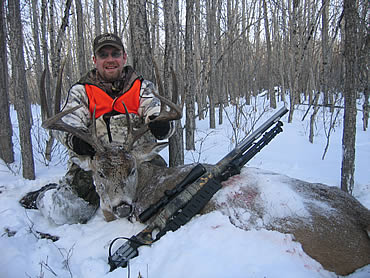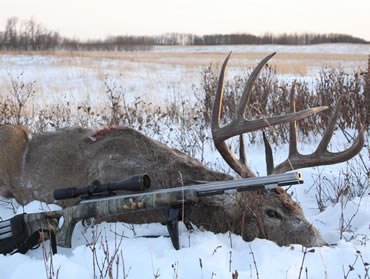Modern muzzleloaders are capable of excellent accuracy, but getting them there takes work.
I was walking a series of small bluffs during a soft deer push when a big buck broke from cover. My buddy yelled to give me the heads up that a deer might be headed my way. I rushed ahead to a clearing with hopes a buck would appear. As if on cue, the tall-racked buck trotted into view.
Wasting no time, I got on my hands and knees and scurried to a point where I could get a clear shot. The whitetail was 176 yards distant as I quickly settled my muzzleloader on shooting sticks, found the animal in my scope and squeezed the trigger. The buck collapsed in its tracks. I quickly reloaded before making my way to the biggest buck I’d taken in years.
Tagging a mature whitetail under any conditions is challenging, but hunting them in native cover, on a soft push and with a muzzleloader made it even sweeter. I had extreme confidence in my trusty frontloader and knew I could make the shot if given an opportunity. The key was preparation.
Getting a new muzzleloading rifle is exciting. When it’s new is also the best time to become familiar with it.
Before you take the rifle out of the box, find the manual. Most instruction booklets provide an outline for preparing your new firearm for the range. Instructions will also show how to disassemble the gun and how to clean and inspect each piece before putting it all back together.
A good initial cleaning helps remove packing grease and heavy oils that protect the firearm during shipping and storage. These coatings ensure the gun arrives in perfect condition, but don’t leave them on your rifle.
Following the manual’s instructions, disassemble your muzzleloader. This will give you the confidence and know-how to break the gun down in the field. The more familiar you are with your gun, the better you’ll maintain it and keep it shooting well.
The next step is to determine if you’ll be using open sights or a scope. Regulations might dictate your choice, but most jurisdictions allow scopes during muzzleloader seasons. When it’s legal, I use a scope. If I can harvest game more efficiently and humanely by using magnified optics, I take advantage of it.
 If you intend to use open sights, you need to decide whether the factory-installed sight is your best option. Everyone’s eyesight is different, and focusing on open sights and a target can be difficult, particularly for older hunters.
If you intend to use open sights, you need to decide whether the factory-installed sight is your best option. Everyone’s eyesight is different, and focusing on open sights and a target can be difficult, particularly for older hunters.
Several of the aftermarket sights are easy to see and make it quicker to acquire a target. Some colors show up better than others, and you need to decide which is best, or even if a fiber-optic sight is the easiest to acquire and keep in focus.
Make sure the mounting screws are tight and secure.
If you plan to use a scope, mount it properly. A good set of bases and rings is essential. Have them properly installed, centered, leveled and tightened. There are some great one-piece bases and rings that make this step easier and reduce alignment issues. Don’t over-tighten the mounting screws. Use a torque tool for best results. Caldwell (www.battenfeldtechnologies.com) makes a torque screwdriver specifically for mounting bases and rings.
Next, you’ll need to position the scope within the rings. Is the scope set for proper eye relief? If you can’t acquire the target quickly and easily, it will always be a struggle to shoot the gun.
If you can’t see objects quickly or clearly, you don’t have the correct eye relief or aren’t looking straight into the scope. Adjust the eye relief until the sight picture extends from edge to edge in the objective lense.
Before heading to the range, you’ll save yourself a lot of headaches by bore-sighting the rifle to get it “on paper.”
I like to season a new rifle. Take it to the range and just shoot it for a day. Work out the bugs and become familiar with the firearm.
 Trigger pull, feel and comfort will help you determine what works and what doesn’t. Can you change what doesn’t work? The length of pull, recoil pad or trigger pull might be user-adjustable. If not, there could be custom options.
Trigger pull, feel and comfort will help you determine what works and what doesn’t. Can you change what doesn’t work? The length of pull, recoil pad or trigger pull might be user-adjustable. If not, there could be custom options.
When you’re happy with the feel of the gun and head to the range for some real tests, start at 25 yards and fine-tune the scope adjustment until you can cluster bullets at, or just above, the bull. Now check the rifle at 100 yards.
Many shooters begin with maximum loads, but not all muzzleloaders can handle the pressures of 150-grain charges. Before shooting your muzzleloader, check with the manufacturer to find the recommended load range.
Staying within the recommended range, fire a three-shot group. Measure the group and record the group size and load information on the target.
With the correct load, modern muzzleloaders are generally very accurate. You just need to shoot different loads to find the one that performs best in your gun.
If you’re shooting a maximum load and can’t get a good group, try reducing the amount of powder. That is, if you are shooting 150-grain loads and can’t get a tight group, drop to 100 grains and see what happens. Did your group tighten up? If so, you’ll need to find a happy medium between accuracy and velocity.
Don’t compromise accuracy for velocity. The hotter the load, the more difficult it is to control accuracy.
Should you use pellets or granulated powder? Is velocity most important, or do you want something that’s easy to clean, faster to load or easy to transport?
Pellets make life simple, but loose powder allows you to fine-tune loads for the perfect balance between accuracy and energy. Both have benefits, and it can be a tough decision.
If you’re using loose powder, try adding 10 grains of powder each time to determine where accuracy begins to fall.
Pick a good bullet, and don’t comprise on quality. The load might be accurate, but if your bullet doesn’t perform, you might as well have missed. Most manufacturers recommend bullets for their rifles, and that’s a good place to start.
The sabot — the plastic cup that surrounds the projectile and holds it snug in the barrel — is usually vital to accuracy. When you shoot, collect expelled sabots from downrange. Check each one for rifling marks. Rifling spins the bullet and keeps it stable in flight. All of your spent sabots should be marked with similar patterns. If not, you have a problem. You can learn a lot from your sabot.
I had trouble getting a new rifle to group, and found that some of the sabots were not engaging the rifling. Some looked pristine, like they’d never been shot; others had rifling marks. The problem was an inconsistent seal between the sabot and the bore, allowing gas to escape. Different sabots solved my problem.
Another option is to shoot PowerBelt bullets (www.powerbeltbullet.com). Instead of a sabot, the PowerBelt uses a plastic ring on the bottom of the bullet. PowerBelts are easy to load and can increase accuracy by providing a consistent gas seal. Some guns like them better than others.
No matter what bullet you choose, make sure to seat it and the sabot straight. Misalignment can cause inaccuracy or even binding and scoring. If necessary, use a short-starter. Resting the rifle on its butt, push straight down with your ramrod.
Practice proper form at the range and shoot off a well-anchored shooting bench. Use a Lead Sled or similar device for maximum stability.
Rest your rifle on the stock, not the barrel. Place the rifle on supports the same way each time. Consistency is the only way to determine the accuracy potential of a rifle.
Set up targets at 25-yard intervals out to the maximium distance you’ll be shooting in the field. I always sight-in at 100 yards. I stake portable targets into the ground and shoot at 25, 50, 75 and 100 yards. The next set should be 125, 150, 175 and 200. If you plan to shoot farther than 200 yards, stretch a third group to 300. That’s where you’ll really learn your gun and your limits. If you can’t consistently make a long shot, never try it on game.
Make sure to swab between each shot so powder residue doesn’t change pressures and accuracy.
Start a diary and record results for each of your loads. Write down the information about your bullet, sabot and powder.
Take that information and make it easy to use in the field. A quick reference guide with bullet drop, point of impact or which reticles to use at various distances will ensure you are always on target.
Stationery shops carry Mylar stickers you can paste on the side of your stock. If nothing else, create a reference card to carry in a hunting jacket.
Shooting a three-leaf clover at the range could foretell a great season, but nothing improves your shooting more than practice.
Today’s muzzleloaders are the best the world has ever seen. It is often the shooter’s form that needs work. Becoming intimate with your gun at the range will give you the confidence and ability to shoot accurately in the field — even when you’re looking down the barrel at a trophy.
Read Recent Articles:
• When Good Stands Go Bad: Even the most careful hunters can pollute a stand if they use it too much.
• The Deadliest Disease: Despite the fear about CWD, far more whitetails succumb to EHD.
• Off-Season Practice: Five Tips that will make you a better shot with a bow.
This article was published in the October 2010 edition of Buckmasters Whitetail Magazine. Subscribe today to have Buckmasters delivered to your home.